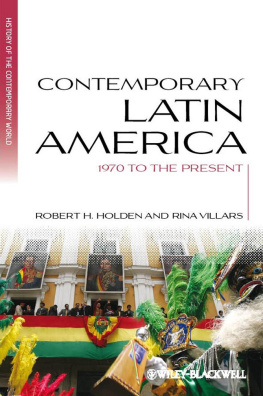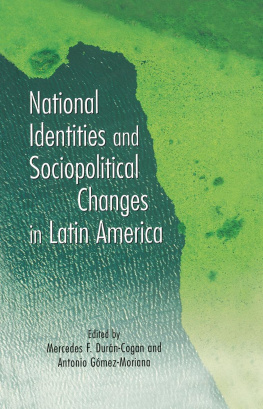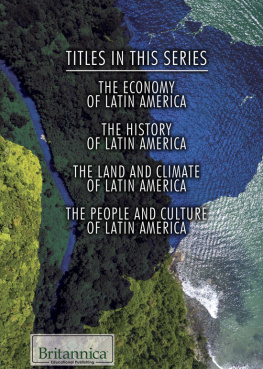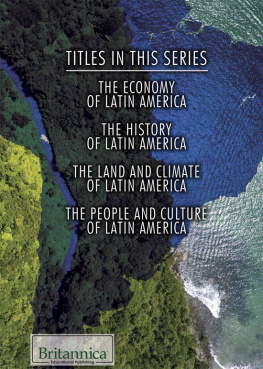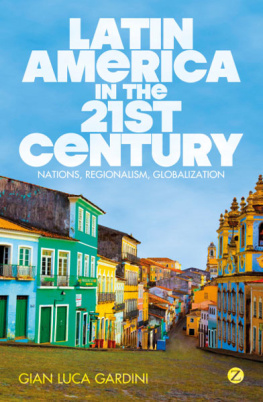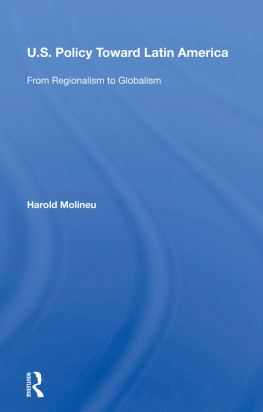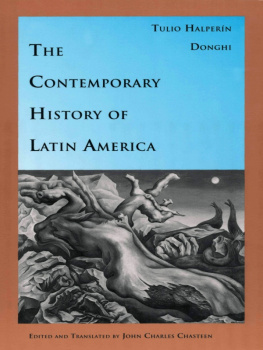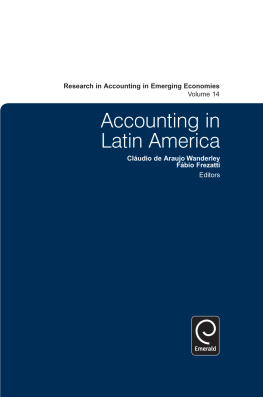
A HISTORY OF THE CONTEMPORARY WORLD
General Editor: Keith Robbins
This series offers an historical perspective on the development of the contemporary world. Each of the books examines a particular region or a global theme as it has evolved in the recent past. The focus is primarily on the period since the 1980s but authors provide deeper context wherever necessary. While all the volumes offer an historical framework for analysis, the books are written for an interdisciplinary audience and assume no prior knowledge on the part of readers.
Published
Contemporary America
M. J. Heale
Contemporary Global Economy
Alfred E. Eckes, Jr.
Contemporary Japan, Second Edition
Jeff Kingston
Contemporary Latin America
Robert H. Holden & Rina Villars
In Preparation
Contemporary China
Yongnian Zheng
Contemporary South Asia
David Hall-Matthews
This edition first published 2013
2013 Robert H. Holden and Rina Villars
Blackwell Publishing was acquired by John Wiley & Sons in February 2007. Blackwells publishing program has been merged with Wileys global Scientific, Technical, and Medical business to form Wiley-Blackwell.
Registered Office
John Wiley & Sons Ltd, The Atrium, Southern Gate, Chichester, West Sussex, PO19 8SQ, UK
Editorial Offices
350 Main Street, Malden, MA 02148-5020, USA
9600 Garsington Road, Oxford, OX4 2DQ, UK
The Atrium, Southern Gate, Chichester, West Sussex, PO19 8SQ, UK
For details of our global editorial offices, for customer services, and for information about how to apply for permission to reuse the copyright material in this book please see our website at www.wiley.com/wiley-blackwell.
The right of Robert H. Holden and Rina Villars to be identified as the authors of this work has been asserted in accordance with the UK Copyright, Designs and Patents Act 1988.
All rights reserved. No part of this publication may be reproduced, stored in a retrieval system, or transmitted, in any form or by any means, electronic, mechanical, photocopying, recording or otherwise, except as permitted by the UK Copyright, Designs and Patents Act 1988, without the prior permission of the publisher.
Wiley also publishes its books in a variety of electronic formats. Some content that appears in print may not be available in electronic books.
Designations used by companies to distinguish their products are often claimed as trademarks. All brand names and product names used in this book are trade names, service marks, trademarks or registered trademarks of their respective owners. The publisher is not associated with any product or vendor mentioned in this book. This publication is designed to provide accurate and authoritative information in regard to the subject matter covered. It is sold on the understanding that the publisher is not engaged in rendering professional services. If professional advice or other expert assistance is required, the services of a competent professional should be sought.
Library of Congress Cataloging-in-Publication Data
Holden, Robert H.
Contemporary Latin America : 1970 to the present / Robert H. Holden, Rina Villars.
pages cm. (History of the contemporary world)
ISBN 978-1-4051-3970-0 (hardback) ISBN 978-1-4051-3971-7 (paper) 1. Latin AmericaHistory1980 2. Latin AmericaHistory20th century. I. Villars, Rina. II. Title.
F1414.3.H65 2013
980dc23
2012016773
A catalog record for this book is available from the British Library.
Cover image: Bolivias new President Evo Morales, right, and the President of Venezuela, Hugo Chavez, wave from the balcony of the presidential palace in La Paz as they watch an Oruro carnival parade, Monday, January 23, 2006. Photo PA Photos / AP Photo / Martin Mejia.
Cover design: www.simonlevyassociates.co.uk
List of Maps, Figures and Tables
| The Hispanic world. |
| Use of cocaine c. 2008. |
| Changes in principal Christian affiliations, 19702010, as proportion of national population. |
| Changes in Latin American regime types and military golpes , 19602011. |
| Perception of the rule of law in Latin America, 2009. |
| Intentional homicide rates. |
| The stragglers: lowest-income Latin American countries, 19602009. |
| The leaders: highest-income Latin American countries, 19602009. |
| Gross domestic product, 19602009, of top three producers. |
| Average annual net number of migrants (immigrants less emigrants, in thousands) by decade. |
| HDI of Latin American countries, 2010. |
| Latin America: changes in crude birth rate, 19502005. |
| Latin America: basic demography, living standards and history. |
| Truth Commission mandates and findings. |
| Net enrollment ratios, primary school. |
| Principal Latin American regional organizations by 2011. |
Series Editors Preface
The contemporary world frequently presents a baffling spectacle: New world orders come and go; Clashes of civilizations seem imminent if not actual; Peace dividends appear easily lost in the post; terrorism and wars on terror occupy the headlines. Mature states live alongside failed states in mutual apprehension. The rules of the international game, in these circumstances, are difficult to discern. What international law is, or is not, remains enduringly problematic. Certainly it is a world in which there are still frontiers, borders and boundaries but both metaphorically and in reality they are difficult to patrol and maintain. Asylum occupies the headlines as populations shift across continents, driven by fear. Other migrants simply seek a better standard of living. The organs of the international community, though frequently invoked, look inadequate to deal with the myriad problems confronting the world. Climate change, however induced, is not susceptible to national control. Famine seems endemic in certain countries. Population pressures threaten finite resources. It is in this context that globalization, however understood, is both demonized and lauded.
Such a list of contemporary problems could be amplified in detail and almost indefinitely extended. It is a complex world, ripe for investigation in this ambitious new series of books. Contemporary, of course, is always difficult to define. The focus in this series is on the evolution of the world since the 1980s. As time passes, and as the volumes appear, it no longer seems sensible to equate the world since 1945 with contemporary history. The legacy of the Cold War lingers on but it is emphatically in the background. The fuzziness about the 1980s is deliberate. No single year ever carries the same significance across the globe. Authors are therefore establishing their own precise starting points, within the overall contemporary framework.
The series treats the history of particular regions, countries or continents but does so in full awareness that such histories, for all their continuing distinctiveness, can only rarely be considered apart from the history of the world as a whole. Economic, demographic, environmental and religious issues transcend state, regional or continental boundaries. Just as the world itself struggles to reconcile diversity and individuality with unity and common purpose, so do the authors of these volumes. The concept is challenging. Authors have been selected who sit loosely on their disciplinary identity whether that be as historians, political scientists or students of international relations. The task is to integrate as many aspects of contemporary life as possible in an accessible manner.
Next page
